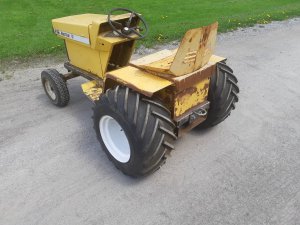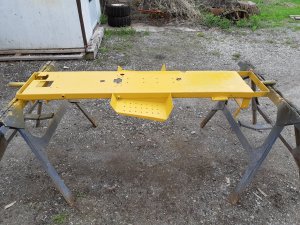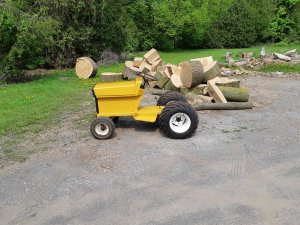It still doesn't apply to what is happening with this setup electrically. It would be different if we were discussing two separate electric tractors coupled together. It wouldn't matter what amperage the other tractor was pulling as each tractor's electrical system doesn't care about the other.
We are talking about connecting two electrical motors together on the same controller, same electrical feed that are mechanically locked together.
I think this project is very interesting. I like the thinking, an electric motor is instant torque verses an internal combustion motor has to develop it's full torque potential. The mechanical advantage in using an electric motor for pulling for seconds at a time is huge (check out formula electric drag boats, stunning). With all the input this is getting, I think it's safe to say, there is a lot of interest in this type of innovation, and an interest in seeing this project succeed. I had to re-examine my first opinion or first reaction after reading all the comments, good input, I like that. This forum tends to have well thought out input. I hope I can do the same.
If I understand the basics of what you are building, you have wired these two motors in parallel on their own circuits, isolating the circuits for a way to both inherently protect them and control/improve performance as you experiment with the system?
By keeping this simple with common parts you build into the project a level of affordability and reduce total risk if something goes wrong (electrical pieces failing but easy to replace and relatively cheap) again if I'm seeing this right.
This looks like a "proof of concept" build, which is how I think most true innovation starts at the grass roots level (for those of us like myself that have to be very creative with limited resources, unlike a big corporation that tends to throw big budgets at product development).
I want to comment on Toomanytoys84 quote now,
I think what he is looking at, at least in part with his shared concern, is that the two isolated electric motors and their circuits are not isolated on the transmission of power side, (the single chain drive to the transmission). I don't want to put words in his mouth if I'm getting this wrong, so please chime in.
My initial reaction was similar because I thought of the current technology being used now in the market, such as hybrid vehicles. I'm not very concerned about motors drawing on isolated circuits, in theory at this point they are perfectly safe as long as the draw voltage, amps, and fuses are correct for each motor. Besides, lets say you got the numbers wrong, you lose a motor as the worst case scenario? Disappointing at worst for a short time, I consider this limited risk, in the process of proving your idea works.
I'm looking at the transmission part because the inevitable inequality between the two identical motors is still going to be present and using chain at least at first (without the opportunity to study if this should even be a consideration) is a precise means of transmitting power. Chain will not slip, at best it might stretch a little before catastrophic failure.
The Hybrids have a form of clutch between two power inputs to ensure the safe transmission of power or disengagement of power to protect the rest of the components plus power sources. Even if it's a "hick-up" in power for a moment the slip that a clutch or belt can give most likely would protect the project until you invent a way around the hypothetical obstacle, if it's even a concern at all.
An uneven load on the same chain or gear without slip protection has a "push pull" effect that may or may not be a problem at the loads being discussed, but I do think is worth examination, I'm not saying I think your project shouldn't be tried as is, this is your work, enjoy the process and know that there are those of us that deeply respect the initiative/risk that gets the job done. This is just my thoughts.
I also took the time to examine battery input with the voltage you gave. I'm guessing you went with an increase in voltage in order to reduce the amount of amps required on the supply line? This would improve safety of the project by controlling heat (if amps = heat, heat the killer of electronics).
Since this project is dealing with DC power in the less than 10-15hp range, your source power will need to supply 5hp worth of power to actually get the rated work from your motors. If watts is the rating for the work completed by an electric motor than you will need a circuit and battery capable of 1,864 watts x 2 (each 2.5hp motor) = 3,728 watts. If you divide 3728/72V you get 51amps. The tech to do this is widely available between forklifts and consumer solar now days.
Each motor may need the ability to draw 26 AHr at minimum (in keeping the circuits isolated, each motor with its own battery source or 52 AHr with one source). Of course I'm basing this on 1 hp = 746 watts. When joining batteries you can double voltage (series, pos to neg) or double AHr (parallel, pos to pos). To use a commonly known battery, HF solar battery with BCI-U1R I think, 12VDC, 35AHr, would be 6 batteries in series, 2 sets? There are more expensive, lighter, smaller, more complex ways to get the same results but this is keeping it simple for discussion.
I look forward to success of your project, and the updates.




